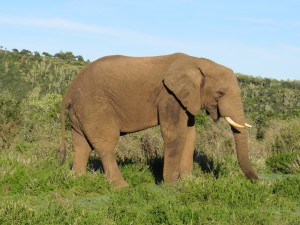Arms get waved hysterically, fights break out between newlyweds and tears are shed by terrified children. Vehicle hooters gets honked and trailers get jack-knifed as people desperately reverse from a young elephant bull who just happens to look their way as he crosses the road. Even worse, some people choose to challenge big bulls that really mean business and end up having their cars calmly swept onto its roof as the elephant continues down his chosen path. There is much consternation between elephants and tourists in the Kruger Park every day but fear no more - Elephants are actually incredibly easy animals to understand if you pay attention to their body language and heed their warning. Read this article and you’ll have a quick and easy guide to understanding elephants and what they are trying to say to you.

Elephants spend a lot of time swishing their tales from side to side, attempting to keep the flies off their body. Just like your dog at home, this wagging tail means you have a happy elephant on your hands. As soon as an elephant becomes distressed it’s tail will become stiff and erect and normally the elephant will hold it out to one side. As soon as the tail is held horizontal to the ground there is a good chance that elephant is going to run. Elephants also use their ears to cool themselves down. They have large veins that lie against the surface of the skin behind their ears and as they flap their giant ears against the wind the blood is cooled down. This cooled blood is then pumped around their bodies and helps to lower their overall body temperature. People often think that as an elephant watches you and slowly flaps its ears backwards and forwards it is warning you of something. Don’t stress, the elephant is just cooling himself down just as a human fans themselves with the hymn book in a hot church. Just like with the elephant’s tail, it will actually hold its ears straight out to the side, unmoving, when it is agitated, attempting to make itself appear as big as possible and hopefully scare you off. So when an elephant walks towards you with ears outstretched, its head held high, its back arched and its tail stiff and then gives you a big head shake slapping those big ears against its body, you are now dealing with an unhappy elephant. Without revving your engine and making the problem worse, quietly drive off leaving the elephants to settle down again.Elephants also make noises, which can let you know what they are thinking. One of these is a deep rumbling noise. Most of the communication between elephants is actually happening at frequencies we can’t even hear because they are too low but this rumbling is one of the ones we can. If you are lucky enough to hear this beautiful, calming rumbling noise, switch your engine off and listen. Basically you are just hearing the elephants chatting to each other and are sitting in on a “tea with the aunties”, so to speak. However when elephants trumpet, this typically suggests they are agitated. It may be a youngster throwing a temper tantrum and we all know how this never goes down well with any mother, or it could be an upset female in estrus who is being harassed by a male wanting to mate. Whatever the case, this is usually a good time to give the elephants a lot more space.

Lastly one of the other misconceptions about elephants is that if they are sweating form their temporal glands (the glands on the sides of their heads) it must mean that they are in musth (a state of heightened testosterone levels that males go into and causes them to go in search of females to mate with). The bulls are typically unreasonably aggressive during this time and should be totally avoided. Now males in musth will most likely be sweating from their temporal glands but this can also happen to females or youngsters when stressed or excited and is not the tell tail sign. Instead look between his hind legs and if he is dribbling a constant dribble of a dark, smelly urine then he is definitely in musth. Give this elephant a wide berth. He is like a teenager with a bad attitude who is angry with the world even if he’s not entirely sure why.

Basically to sum it up, treat elephants with a bit of respect. A lot of dominance struggles in the bush are about size. As you drive down the road, impala make way for you and as an elephant walks down the road, he assumes you will make space for him. By listening carefully to what the animals are saying to you and reacting to that, you are guaranteed to return to camp in the evening with your car and family peace intact.
Wonderful post by Amy Attenborough, a guide at Ngala Safari Lodge in the Kruger National Park.
Check out her amazing “workplace” and more phenomenal Safari destinations here: www.safari.com/lodges/ngala-safari-lodge

Elephant culling has always been a controversial issue but with the release of elephant contraceptives in South Africa, do you think this will be the end of culling? Discover more about elephant contraceptives here.


